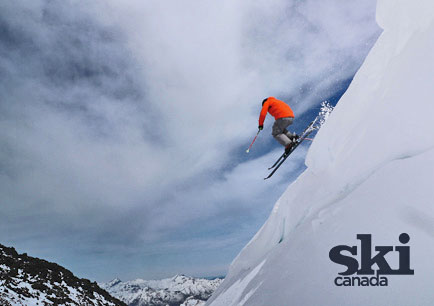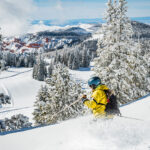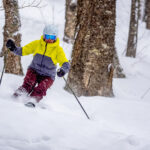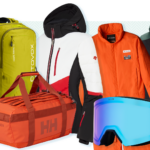Text and photos BY Nigel Harrison, CSIA III, CSCF II
As we limp, groan and stagger defiantly into middle age, it’s tempting to think we should keep both skis firmly in contact with the snow. But this needn’t always be the case. With good judgement and some simple technique, even pot-bellied, balding skiers (and instructors) can “huck their meat” from time to time. In the following photos, chiselled Section 8 coach Tobin Leopkey demonstrates how it’s done.
A few basic rules:
* Big meat, small huck.
* Before hucking, look for steep landings with nice long, clear run-outs.
* Huck on your second run: best to ski the slope below first to check for soft snow on the landing. Try to avoid landings with rocks, trees, ski patrol toboggans, après-ski gatherings and other hazards.
* If young people are watching, feign boot buckle problems and wait until they’ve departed before you huck. (They’ll have done something three times bigger and far more impressive before breakfast.)

1
Takeoff. At this moment it’s easy to let the meat drop back behind your feet. Pushing your hands forward helps keep your body over the centre of the skis. Takeoff is critical to the landing and can’t be repaired mid-air—so get it right before you leave earth. In the photo, Tobin is already assessing where exactly he will land. Try to take off with your shoulders square to the landing to avoid accidental rotation. Peek over the edge so you know which way the landing slopes to achieve this.

2
In mid-flight, Tobin assesses the factors that will affect how his skis behave on landing. For example, is the snow soft but fast, or soft and sticky? How steep is the terrain? How tracked up is the landing? This dictates how the speed of the skis will change relative to the speed of the body on landing, and thus the likelihood of a faceplant, a clean landing or toppling onto your back.

3
It looks as if Tobin decided the snow looked pretty sticky and has moved his feet forward in anticipation of his skis slowing on contact with the snow. As he nears earth he extends his legs, as if he’s reaching for it. Extended legs allow for more bending to absorb the impact of the landing. You can practise this on a trampoline at a neighbour’s backyard barbecue: bounce as high as you can and then try to land on the mat without getting bounced back in the air. You will achieve this by stretching for the mat and then flexing the knees, legs, body as the feet touch, allowing the mass to decelerate slowly.

4
On landing, Tobin bends to absorb impact and improve his chances of staying on his feet. The ankles, knees and hips all come into play here. As it turns out, in this instance, the snow was not as slow as Tobin expected, so his skis didn’t slow as much as anticipated and he’s found himself with his (significant) mass caught slightly behind his base. Since he was close to being in balance prior to landing, and has a perfectly honed core, he’s able to pull his mass back over the base and ski away—to what passes for glory in middle age.
NIGEL HARRISON and TOBIN LEOPKEY of Section 8 Snowsport Institute offer ski improvement camps for intermediate and expert skiers in all terrain and conditions in B.C., the Alps, Japan and Chile.
www.section8ski.com



